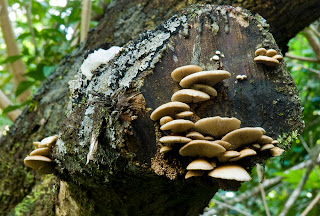Plants on Hawaii have many different origins, some indigenous, others alien. Endemic plants are those species that evolved in isolation on the Hawaiian islands and are found nowhere else. Indigenous plants are those that colonized the island before the arrival of humans, such as those that arrive on the winds or over the ocean. Plants introduced by the first travelers to Hawaii, the Polynesians, are regarded as native. Most of these plants have important uses for food, fiber, medicine, and spiritual significance. Alien species are the plants introduced after the late 1700s since contact with European explorers. Some plants were brought purposely, many were accidental weed introductions. Many alien species are escaped cultivated plants and fruit trees, and many are causing damage to the native and less hardy Hawaiian plants.
 |
| Tropical almond seedlings and kernels on the beach |
 |
| Tropical almonds, from green to opened nut |
This kernel is a bit of a pain to open without smashing the elongated, small seed inside, but it can be managed. Matt Kirk showed us one method of selecting the largest and driest of the scattered nut kernels along the beach to open with a machete. Robert attempted a few more ideas on opening the kernels by leveling off one pointed end of the kernel and striking it in the right place along a naturally occurring seam to get the kernel to open cleanly in two halves with the nut intact. He and Robert then opened several handfuls of the nuts to let Gillian sample the nutmeat. The taste is a blend of coconut and almond, very delicious. It might seem like the effort for such a small amount of food is not worth it, but with the wonderful tropical sunshine and on being vacation with no schedule, it is almost fun. Matt told us about a Euell Gibbons book titled Beachcombers Handbook that describes his experiences with tropical almonds and his three years of living off the land in Hawaii. It is currently out of print, but I think we'll try to get a copy of it for its stories and lore. With this little bit of knowledge and experience, we look forward to opening and eating more on our next vacation.



















